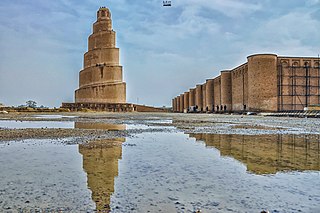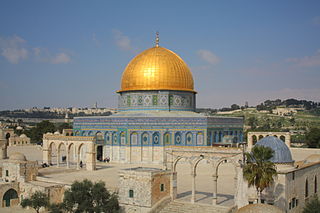
The architecture of Iraq encompasses the buildings of various architectural styles that exist in Iraq.

The architecture of Iraq encompasses the buildings of various architectural styles that exist in Iraq.
| | This section is empty. You can help by adding to it. (January 2021) |

Islamic architecture would flourish during the Umayyad, Abbasid, and Ottoman periods.
Under Early Caliphs buildings and Mosques were built. The city of Basra was founded by caliph Omar.
Kufa was also founded by Omar and given its name in 637–638 CE, about the same time as Basra. The region of Iraq was the important Military base of early Caliphate
Umayyad architecture developed in the Umayyad Caliphate between 661 and 750, primarily in its heartlands of Syria, Palestine and Iraq.
The Umayyad caliphate was established in 661, when Caliph Hasan abdicated to Muawiyah ibn Abi Sufyan, founder of the Umayyad dynasty. Muawiyah I, governor of Syria, became the first Umayyad caliph. Under the Umayyads the Arab empire continued to expand, eventually extending to Central Asia and the borders of India in the east, Yemen in the south, the Atlantic coast of what is now Morocco and the Iberian peninsula in the west. [3] The Umayyads built new cities, often unfortified military camps that provided bases for further conquests. Wasit in Iraq was the most important of these, and included a square Friday mosque with a hypostyle roof. [3]
In the mid 8th century, the Round city of Baghdad was founded as the Abbasid capital, following the Abbasid victory over the Umayyad caliphate. While the Umayyads had typically reused pre-Islamic buildings in the cities they had conquered, by the Abbasid era many of these structures required replacement. Abbasids founded many cities throughout the Empire. In 836 Samarra was founded. The core area of the city was initially constructed in the reign of al-Mu'tasim, with further development taking place under al-Wathiq and al-Mutawakkil. [4]
The Al-Wazeer Mosque, Al-Maqam Mosque, are examples of Ottoman architecture in Iraq.
In the 1950s, as Iraq became wealthier due to oil revenue during the reign of King Faisal II, several important projects were commissioned. Numerous foreign architects, including Walter Groupius and Le Corbusier were invited to Iraq to design various public buildings during this period. [5] Among these was American architect Frank Lloyd Wright, who drew up the Plan for Greater Baghdad, which would include a cultural center, opera house, and university on the outskirts of Baghdad. [5] However, it was never built due to the collapse of the monarchy in 1958.
During his tenure as President, Saddam Hussein oversaw the construction of several monuments and palaces, including the Victory Arch and al Faw Palace. [6] Many of these have been described as tacky, and unrepresentative of actual Iraqi architectural tradition. [7] [8]

The Umayyad Caliphate or Umayyad Empire was the second caliphate established after the death of the Islamic prophet Muhammad. The caliphate was ruled by the Umayyad dynasty. Uthman ibn Affan, the third of the Rashidun caliphs, was also a member of the clan. The family established dynastic, hereditary rule with Muawiya ibn Abi Sufyan, long-time governor of Greater Syria, who became caliph after the end of the First Fitna in 661. After Mu'awiya's death in 680, conflicts over the succession resulted in the Second Fitna, and power eventually fell to Marwan I, from another branch of the clan. Syria remained the Umayyads' main power base thereafter, with Damascus as their capital.

The Abbasid Caliphate or Abbasid Empire was the third caliphate to succeed the Islamic prophet Muhammad. It was founded by a dynasty descended from Muhammad's uncle, Abbas ibn Abd al-Muttalib, from whom the dynasty takes its name. They ruled as caliphs for most of the caliphate from their capital in Baghdad in modern-day Iraq, after having overthrown the Umayyad Caliphate in the Abbasid Revolution of 750 CE (132 AH). The Abbasid Revolution had its origins and first successes in the easterly region of Khorasan, far from the bases of Umayyad power in Syria and Iraq. The Abbasid Caliphate first centered its government in Kufa, modern-day Iraq, but in 762 the caliph Al-Mansur founded the city of Baghdad, near the ancient Babylonian capital city of Babylon and Persian city of Ctesiphon. Baghdad became the center of science, culture, and invention in what became known as the Golden Age of Islam. This, in addition to housing several key academic institutions, including the House of Wisdom, as well as a multiethnic and multi-religious environment, garnered it an international reputation as the "Centre of Learning".

Abū Jaʿfar ʿAbd Allāh ibn Muḥammad al-Manṣūr usually known simply as by his laqab al-Manṣūr (المنصور) was the second Abbasid caliph, reigning from 136 AH to 158 AH succeeding his brother al-Saffah. He is known for founding the 'Round City' of Madinat al-Salam, which was to become the core of imperial Baghdad.

Samarra is a city in Iraq. It stands on the east bank of the Tigris in the Saladin Governorate, 125 kilometers (78 mi) north of Baghdad. The modern city of Samarra was founded in 836 by the Abbasid caliph al-Mu'tasim as a new administrative capital and military base. In 2003 the city had an estimated population of 348,700. During the Iraqi Civil War, Samarra was in the "Sunni Triangle" of resistance.

A minaret is a type of tower typically built into or adjacent to mosques. Minarets are generally used to project the Muslim call to prayer (adhan) from a muezzin, but they also served as landmarks and symbols of Islam's presence. They can have a variety of forms, from thick, squat towers to soaring, pencil-thin spires.

Kufa, also spelled Kufah, is a city in Iraq, about 170 kilometres (110 mi) south of Baghdad, and 10 kilometres (6.2 mi) northeast of Najaf. It is located on the banks of the Euphrates River. The estimated population in 2003 was 110,000. Currently, Kufa and Najaf are joined into a single urban area that is mostly commonly known to the outside world as 'Najaf'.

The Great Mosque of Samarra is a mosque from the 9th century CE located in Samarra, Iraq. The mosque was commissioned in 848 and completed in 851 by the Abbasid caliph Al-Mutawakkil who reigned from 847 until 861. At the time of construction, it was the world's largest mosque. It is known for its 52 metres (171 ft) high minaret encircled by a spiral ramp. The mosque is located within the 15,058-hectare (37,210-acre) Samarra Archaeological City UNESCO World Heritage Site, listed in 2007.
Al-Qaṭāʾi was the short-lived Tulunid capital of Egypt, founded by Ahmad ibn Tulun in the year 868 CE. Al-Qata'i was located immediately to the northeast of the previous capital, al-Askar, which in turn was adjacent to the settlement of Fustat. All three settlements were later incorporated into the city of Cairo, founded by the Fatimids in 969 CE. The city was razed in the early 10th century CE, and the only surviving structure is the Mosque of Ibn Tulun.

Al-Karkh or just Karkh is historically the name of the western half of Baghdad, Iraq, or alternatively, the western shore of the Tigris River as it ran through Baghdad. The eastern shore is known as al-Rusafa. Historically, al-Karkh has been a commerce market during the Abbasid Caliphate, located outside the main Round City due to safety concerns. It saw many exports and was the main business place for merchants and craftsmen. Al-Karkh has also historically suffered from infighting, fire, and floods that impacted its population and topography.

The Round City of Baghdad is the original core of Baghdad, built by the Abbasid Caliph al-Mansur in 762–766 CE as the official residence of the Abbasid court. Its official name in Abbasid times was City of Peace. The famous library known as the House of Wisdom was located within its grounds.

Abbasid architecture developed in the Abbasid Caliphate between 750 and 1227, primarily in its heartland of Mesopotamia . The great changes of the Abbasid era can be characterized as at the same time political, geo-political and cultural. The Abbasid period starts with the destruction of the Umayyad ruling family and its replacement by the Abbasids, and the position of power is shifted to the Mesopotamian area. As a result there was a corresponding displacement of the influence of classical and Byzantine artistic and cultural standards in favor of local Mesopotamian models as well as Persian. The Abbasids evolved distinctive styles of their own, particularly in decoration. This occurred mainly during the period corresponding with their power and prosperity between 750 and 932.

Umayyad architecture developed in the Umayyad Caliphate between 661 and 750, primarily in its heartlands of Syria and Palestine. It drew extensively on the architecture of older Middle Eastern and Mediterranean civilizations including the Sassanian Empire and Byzantine Empire, but introduced innovations in decoration and form. Under Umayyad patronage, Islamic architecture began to mature and acquire traditions of its own, such as the introduction of mihrabs to mosques, a trend towards aniconism in decoration, and a greater sense of scale and monumentality compared to previous Islamic buildings. The most important examples of Umayyad architecture are concentrated in the capital of Damascus and the Greater Syria region, including the Dome of the Rock, the Great Mosque of Damascus, and secular buildings such as the Mshatta Palace and Qusayr 'Amra.
The following is a timeline of the history of the city of Baghdad, Iraq.
The Ushrusaniyya were a regiment in the regular army of the Abbasid Caliphate. Formed in the early ninth century A.D., the unit consisted of soldiers who were originally from the region of Ushrusana in Transoxiana. The Ushrusaniyya initially served under the prominent general al-Afshin, but they remained active after his downfall, and are frequently mentioned during the period known as the Anarchy at Samarra.

Samarra is a city in central Iraq, which served as the capital of the Abbasid Caliphate from 836 to 892. Founded by the caliph al-Mu'tasim, Samarra was briefly a major metropolis that stretched dozens of kilometers along the east bank of the Tigris, but was largely abandoned in the latter half of the 9th century, especially following the return of the caliphs to Baghdad.
The Asawira were a military unit of the Rashidun and Umayyad Caliphate. The unit consisted of Iranian noblemen who were originally part of the aswaran unit of the Sasanian army. It was disbanded in 703 by al-Hajjaj ibn Yusuf.
In 633 CE, the Arab invasion of Iran began, and finally in 654 CE it would lead to the fall of the Sassanid Empire and Iran would come under the rule of the Rashidun, Umayyad and Abbasid caliphs.
Sulaymān ibn al-Manṣūr, better known as Sulaymān ibn Abī Jaʿfar, was an Abbasid prince and served as governor of Basra, al-Jazira and Syria during the reign of his nephew, Caliph Harun al-Rashid. He also served in Syria under al-Rashid's son and successor, al-Amin.
The Khadra Palace, known in Arabic as Qubbat al-Khadra, was a residence of the Umayyad caliphs in Damascus. It was founded by the first Umayyad caliph, Mu'awiya I, while he was governor of Syria under Caliph Uthman. The Khadra Palace consisted of a series of interconnected buildings, including the caliphal residence, stables, mint and prison, situated directly behind the Umayyad Mosque. Little information is available describing the structure, other than the green color of its dome, its construction from baked brick, timber and marble pavement and its setting amid gardens.